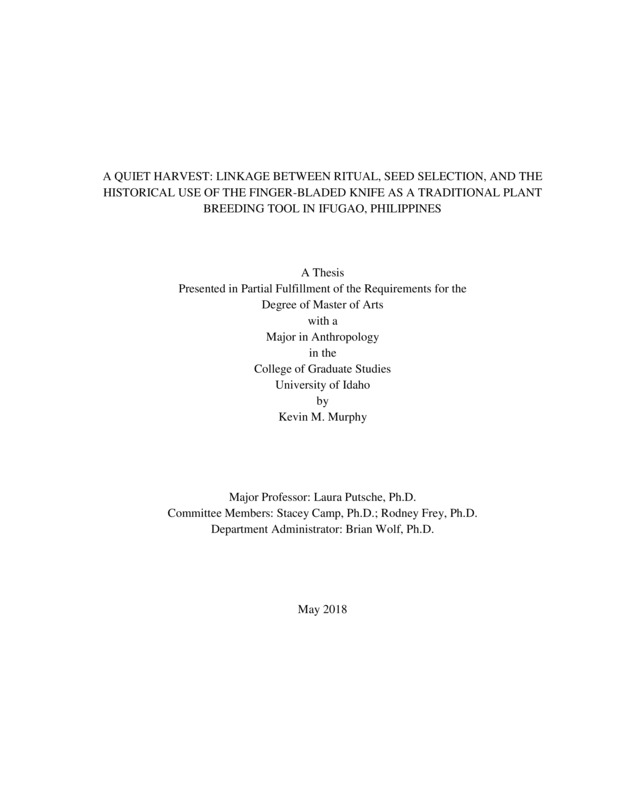A QUIET HARVEST: LINKAGE BETWEEN RITUAL, SEED SELECTION, AND THE HISTORICAL USE OF THE FINGER-BLADED KNIFE AS A TRADITIONAL PLANT BREEDING TOOL IN IFUGAO, PHILIPPINES
Murphy, Kevin. (2018-05). A QUIET HARVEST: LINKAGE BETWEEN RITUAL, SEED SELECTION, AND THE HISTORICAL USE OF THE FINGER-BLADED KNIFE AS A TRADITIONAL PLANT BREEDING TOOL IN IFUGAO, PHILIPPINES. Theses and Dissertations Collection, University of Idaho Library Digital Collections. https://www.lib.uidaho.edu/digital/etd/items/murphy_idaho_0089n_11378.html
- Title:
- A QUIET HARVEST: LINKAGE BETWEEN RITUAL, SEED SELECTION, AND THE HISTORICAL USE OF THE FINGER-BLADED KNIFE AS A TRADITIONAL PLANT BREEDING TOOL IN IFUGAO, PHILIPPINES
- Author:
- Murphy, Kevin
- Date:
- 2018-05
- Program:
- Anthropology
- Subject Category:
- Ethnic studies
- Abstract:
-
The transverse harvest knife, also commonly called the finger or finger-bladed knife, has been utilized by rice farmers in southeast Asia for many centuries. The finger knife persisted in many traditional cultures long after the introduction of the sickle, a tool which provided farmers with the means to execute a much faster harvest. Several theories in interpretative archaeology have attempted to account for this rejection of more modern technological innovations. These theories, which include community-based social organization ideas and practical reasons for the continued use of the finger knife, are presented in this paper. Here I suggest an alternate theory based on a re-interpretation of existing research and fusion of existing theories: the primary reason for the historical and continued use of the finger knife is for seed selection through a centuries old tradition of plant breeding. Though I accept the accuracy of the practical and community-based, socio-cultural reasons for the use of the finger knife put forth by other authors, I suggest that seed selection and genetic improvement was the driving factor in the use of the finger knife. Indeed, intricate planting and harvesting rituals, which both ensured and encouraged varietal conservation and improvement co-evolved with the use of the finger knife as the primary harvest tool due to its unique ability to aid the farmer in the art and science of seed selection. When combined with previous ideas, this interpretative theory, based on the connection between ethnoagronomy and material culture, may provide a more complete picture of the story around the persistence of the finger knife in traditional rice-growing cultures in southeast Asia. I focus my theory on the terrace-building Ifugao people in the mountainous Cordillera region of northcentral Philippines; however, to put the use of the finger into a wider regional context, I draw from examples of the use of the finger knife in other traditional cultures throughout the region of southeast Asia.
- Description:
- masters, M.A., Anthropology -- University of Idaho - College of Graduate Studies, 2018-05
- Major Professor:
- Putsche, Laura
- Committee:
- Frey, Rodney; Camp, Stacey
- Defense Date:
- 2018-05
- Identifier:
- Murphy_idaho_0089N_11378
- Type:
- Text
- Format Original:
- Format:
- application/pdf
- Rights:
- In Copyright - Educational Use Permitted. For more information, please contact University of Idaho Library Special Collections and Archives Department at libspec@uidaho.edu.
- Standardized Rights:
- http://rightsstatements.org/vocab/InC-EDU/1.0/

